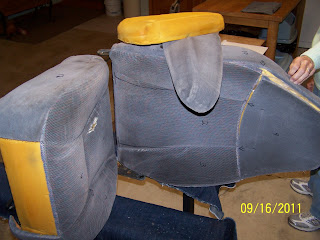 |
August 2011, ready for restoration.
See more photos of car on photos page. |
The 1934 Ford sedan has been in our family for just under fifty years. The car was originally purchased in 1963 or 1964 by my Dad and his brother, Ron and Don Abell. They borrowed $200.00 from the National Bank of Greenwood, in their home town, for the purchase. The seller, who lived on East Washington Street in Indianapolis, Indiana, decided to move to California and could not take the car with him. This seller had replaced the original engine with a flathead engine from a 1953 Mercury mated to a late 1930's floor shift transmission.The car had the original spoke wheels on it, but the fenders, radiator, front grill, doors, running boards, hood, rear backsplash, bumpers, seats, and many other items rode to their new location in the back of a pickup truck. As the truck towed the remaining parts attached to the frame, Ron steered the car while sitting on a milk crate.
During the next year (1964 or 1965), Ron and Don bolted the body parts to the frame and installed glass on the '34 Ford. When they completed this, they towed the car to Acton Indiana. Jack Rayburn a local mechanic wired the car and brought it back to life. The car was driven back to Greenwood for paint. Harry Wagner coated the car with Black lacquer paint. This would be the last job completed at his paint shop at the corner of Fry Road and Madison Avenue in Greenwood as this location was to become a Shell Oil gas station. Fourteen inch Chrysler wheels originally put on the car were later replaced with chrome wheels from an early model International Scout. Bill Hendley sewed a black leather roll and tuck interior for the car and installed it in his Phillips 66 station in Franklin Indiana.
 |
The car as it was mechanically restored
by Ron Ennis in 2006. |
The car stayed in this condition, including mechanical brakes, until 2006 (?). During this time the car was always garaged at either Ron or Don's house and seldom driven. In 2006 (?), Ron and Don took the car to street rod builder Ron Ennis for a mechanical overhaul. Ron Ennis replaced the engine and drive train with one from a late model Mustang (1988-1991). The front end of a Ford Mustang II/Pinto updated the original front wheel assembly. Ron Ennis also added air conditioning to the car during the update. With a drive train in the car that was mechanically sound, Don took the car to Oklahoma City in 2006 (?) for the Streetrod Nationals. After this trip, the car again mostly sat in storage. In 2011, Don sold his share of the car to Ron's son. Currently restoration continues on the car.














